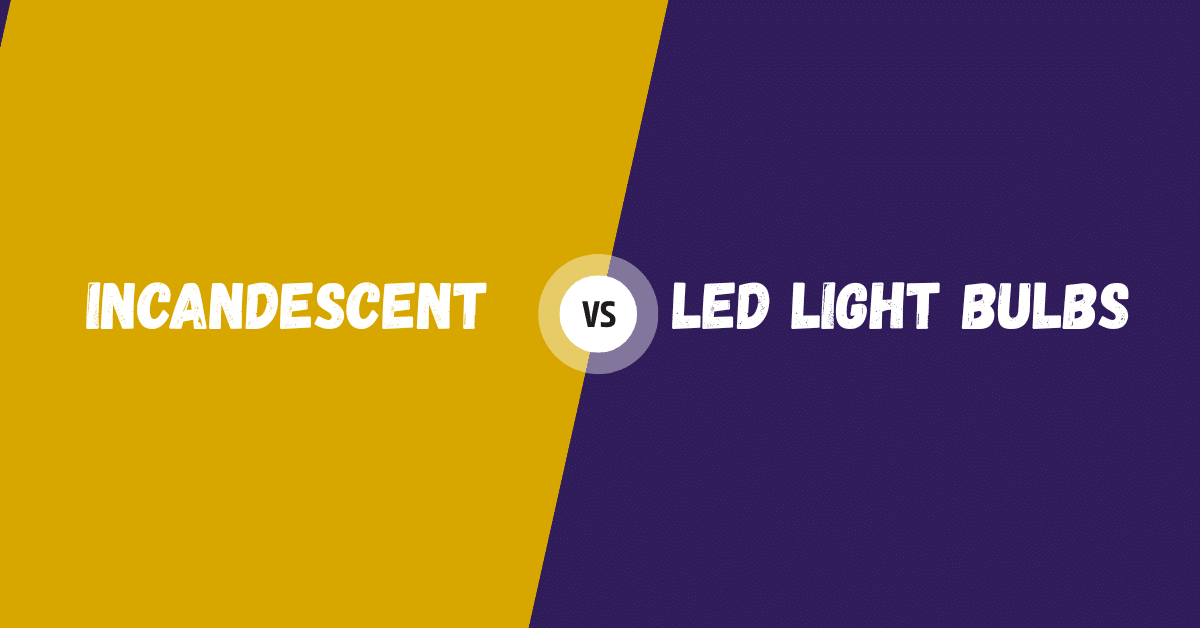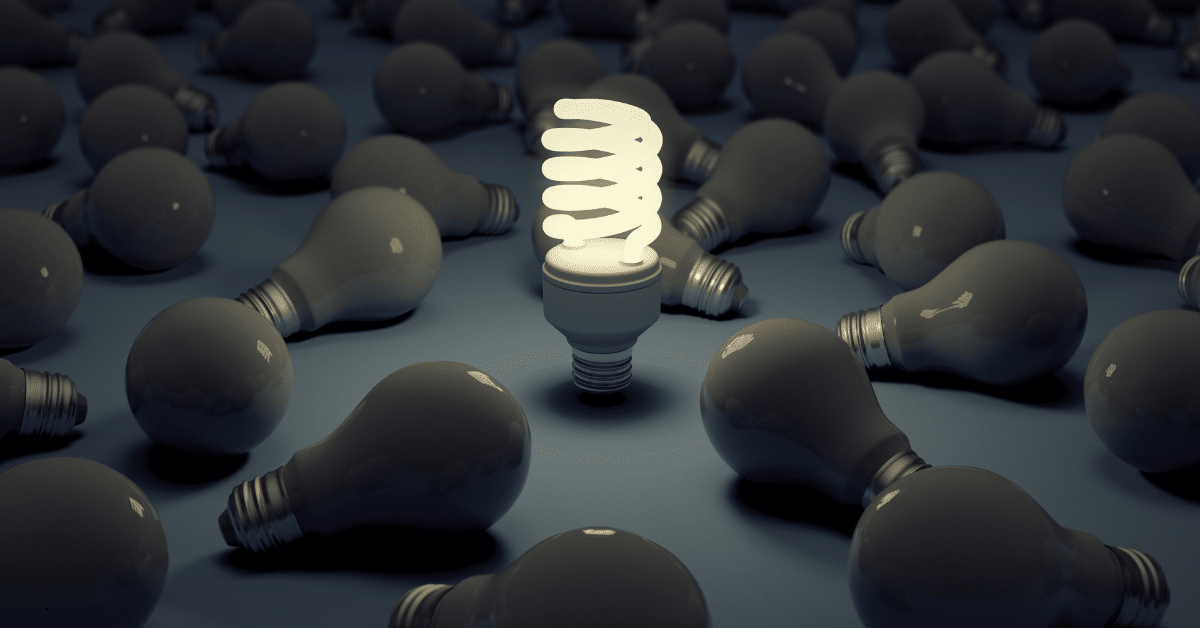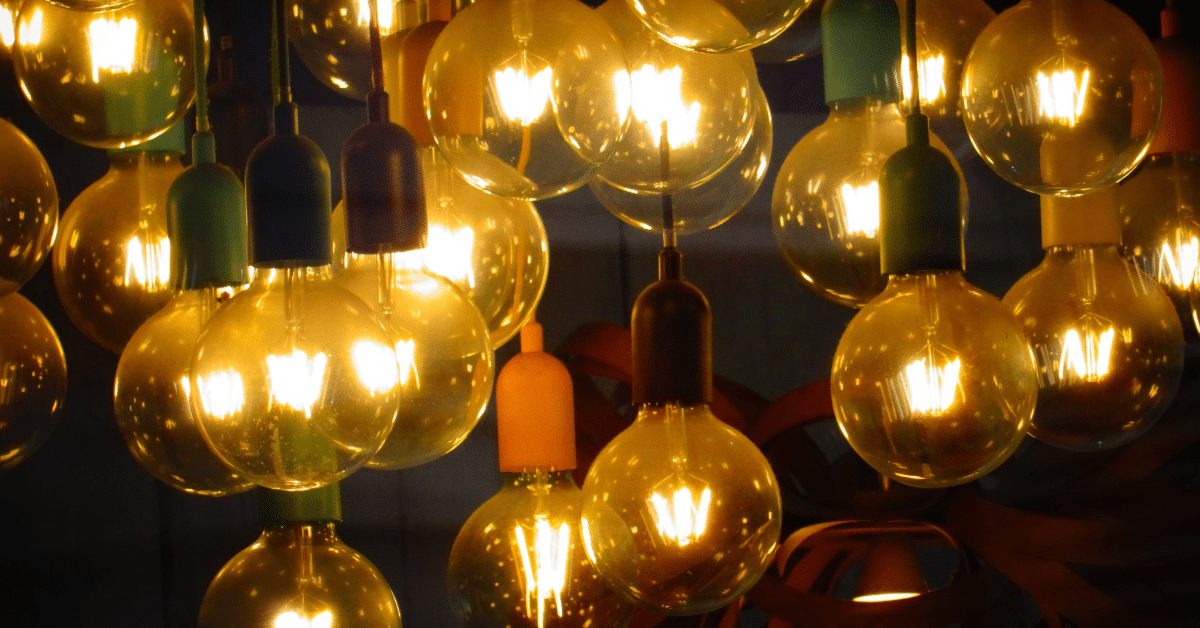
Incandescent Light Bulb vs LED: A Comprehensive Comparison
Incandescent bulbs are the classic “ light bulb ” technology – a tungsten hair-like filament inside a glass-enclosed case glows when heated by electric current. LEDs (Light Emitting Diodes) are ultramodern semiconductor bias that emit light when electrons recombine with holes in a p-n junction( electroluminescence). In practice, LEDs use technical chips (frequently with phosphors or mixed RGB emitters) to produce broad-spectrum white light, whereas incandescents produce light by blackbody radiation of the hot hair-like filament. In this article, we will explore the incandescent light bulb vs LED in detail.

LED vs Incandescent Efficiency and Lumen Output
LED bulbs far outshine incandescents in effecicency and lumen output. A standard 60 W incandescent produces only about 15 – 17 lumens per watt, yielding roughly 800 lm (low light). By discrepancy, typical LED bulbs now deliver 80 – 100 lm/ W (around 800 lm from only 8 – 10 W). State ‑ of ‑ the ‑ art LEDs exceed 120 – 150 lm/ W, and DOE systems they may surpass 150 lm/W in coming years. In other words, LEDs use about 75 – 90 lower electricity for the same light lumen output. For illustration, a 10W LED can emit light as much as 60 W incandescent.)
Table 1 below summarizes performance criteria for both categories;
| Feature | Incandescent | LED |
|---|---|---|
| Lifespan | ~1,000 hours | 15,000–25,000+ hours |
| Luminous Efficacy | ~15–17 lm/W | ~80–100 lm/W (up to ~150 lm/W) |
| Warm-up Time | Instant | Instant |
| Dimmable | Yes (with any standard dimmer) | Dimmable models available (requires compatible LED dimmers) |
| Color Temp. | ~2700 K (warm white) | 2200–6500 K (warm to cool) |
| Color Rendering (CRI) | ~100 (blackbody spectrum) | Typically 80–95+ (high-end LEDs ≥90) |
| Heat Output | Very high (~90% of energy as heat) | Low (LEDs run cool) |
| Initial Cost | Low (<$1–$2 per bulb) | Higher (several $ per bulb) |
| Energy Use | High (e.g. 60 W for ~800 lm) | Low (e.g. ~10 W for ~800 lm) |
| Lifetime Cost | High (frequent replacement, high wattage) | Low (long-life, low wattage) |

Table 2 below shows typical wattage for equivalent brightness;
| Brightness (Lumens) | Incandescent Equivalent | LED Equivalent |
|---|---|---|
| ~450 lm | 40 W incandescent | ~6–7 W LED |
| ~800 lm | 60 W incandescent | ~10 W LED |
| ~1,100 lm | 75 W incandescent | ~12 W LED |
| ~1,600 lm | 100 W incandescent | ~16 W LED |

LED vs Incandescent Lifespan and Durability
Incandescent bulbs burn out quickly. A typical home incandescent light bulb lasts approx. 1000 hours. In discrepancy, ultramodern LEDs are rated for tens of thousands of hours approx. 15,000 – 25,000 hours is common, and numerous LED lights can reach 30 – 50 times the life of an incandescent. For illustration, DOE states LEDs last “ up to 25 times longer ” than incandescents, and quality LEDs can last “ 30 times as long ”. This huge lifetime means LED bulbs may not need replacing in numerous home operations.
LED bulbs are also more durable. They use solid- state components that are frequently boxed in plastic or epoxy resin with no fragile glass hair like filament, so they repel shock and vibration. LED light strings are “ much cooler ” and “ much more resistant to breakage ” than incandescent strings. Incandescents, by comparison, have very thin tungsten fibers and glass bulbs that shatter very easily.
LED vs Incandescent Intial Cost vs Long- Term Cost
Incandescent bulbs are extremely cheap to buy but expensive to use. An ordinary incandescent might cost under $ 1, whereas an LED of analogous brilliance costs several $ (though prices have plunged approx.90% since 2008). But, low purchase price is deceiving the high energy consumption and short life of incandescents lead to much advanced operating costs over time. DOE estimates that the average home saves about $225 per year on electricity by switching from incandescents to LEDs. Likewise, an analysis set up that replacing each incandescent with an LED yields roughly $ 50 –$ 150 in energy savings over that incandescent bulb’s lifetime. In other words, indeed though LEDs cost more upfront, the lifespan cost (energy plus replacement bulbs) is far lower for LEDs.
The DOE notes that “ the cost of LED light bulbs has dropped dramatically ”, and they still save money because they last long and use very less power. In summary, incandescents may save a few $ initially but waste numerous times more money on electricity and frequent replacements. Over a decade, switching all incandescents for LEDs in one home can save hundreds of $ on electricity bills.
LED vs Incandescent Light Quality
Incandescent bulbs emit a very warm, yellowish-white light (around 2700 K), pleasing to the eye in many settings. Their spectrum is essentially that of a blackbody radiator, giving a Color Rendering Index (CRI) of ~100 – the ideal score. This means incandescents show colors extremely accurately (for example, a 2700 K incandescent is scored CRI 100).
LED bulbs now come in a wide range of color temperatures. You can buy warm-white LEDs (2700 – 3000 K) that mimic classic incandescents, as well as cooler “ daylight ” LEDs( 5000 – 6500 K) for out-of-door use. Ultramodern LEDs generally achieve CRI values of 80 – 95. High- quality LED lights claim CRI of 90 – 98. While a many cheap LEDs may have lower CRI (70 – 80) that render colors less naturally, the LEDs can compete or indeed match incandescent color fidelity. In practice, consumers seeking color quality should look for LEDs labeled CRI 90 plus; these approx. the look of incandescents.
LED vs Incandescent Impact on the Environment
LEDs have a clear environmental advantage because they use far less electricity. Reduced energy use directly cuts greenhouse gas emissions, DOE/ EIA states that LED adoption could top 569 TWh annually by 2035 equal to the output of dozens of 1,000 MW power plants. In practical terms, replacing incandescents with LEDs greatly cuts CO ₂ emissions (one estimate finds LEDs produce 80% less greenhouse gases per unit of light than incandescents). Additionally, incandescents’ wasted heat contributes to heating or air conditioning loads; LEDs produce little heat (and DOE points out they “produce further heat ” only because incandescents do).
While we talk about dangerous material; incandescent bulbs contain no poisonous chemicals (just glass and tungsten), whereas LEDs contain small quantities of metals in their semiconductors (gallium, indium, etc.) and solder (lead, arsenic, cadmium traces). Still, unlike fluorescent lights, LEDs contain no mercury, simplifying disposal. Consumers should recycle LEDs at end- of- life (numerous communities collect them like electronics) to avoid filtering of the heavy-metals content. Overall, energy savings from LEDs extensively overweigh these minor disposal issues. As one DOE expert notes, using LEDs “ lessens health burden ” by cutting the fossil-fuel pollution from electricity generation.
LED vs Incandescent Heat Output and Safety
Incandescent bulbs run extremely hot. Approximately 90% of an incandescent’s power is emitted as heat rather than light. A 60 W incandescent can reach over 250°C (450°F), getting dangerously hot to touch or run in enclosed fixtures. This is why incandescents are sometimes used as heat lamps (for brooders, plants, etc.) – their heat is a byproduct. But for general lighting, that wasted heat is a fire hazard and energy loss.
LED bulbs stay cool. DOE sates that LEDs emit very little heat ”. This makes them safer e.g. LED Christmas lights do not heat and are far less likely to start fires. LEDs’ cool operation also makes them ideal for enclosed or heat-sensitive fixtures in closets, recessed cans, or any place where added heat is undesirable. In summary, LEDs offer a major safety advantage by eliminating the burn and fire threat of hot incandescent filaments.
Applications of LED vs Incandescent
Both technologies can be used in numerous settings, but LEDs are now preferred;
Home lighting: LEDs are suitable for every home fixture. They come in the same shapes (A19, candle, globe, etc.) and bases (E26/ E27, candelabra, etc.) as incandescents, so the replacement is simple. Warm-white LEDs emulate the cozy gleam of incandescents in living apartments and bedrooms. All types of home lighting – from ceiling fan to illuminate lamps – are now served by LEDs. Incandescents are now largely obsolete in homes, except occasionally inexpensive or ornamental bulbs where efficiency is not yet intended. DOE notes that switching an old 60 W bulb with a 10 W LED yields the same light.
Commercial/ Office: Offices and stores favor LEDs for effectiveness and long life. Numerous commercial fixtures have been converted from incandescent/ halogen to LED or fluorescent. LEDs are available in cooler color temperatures (3500 – 5000 K) that are suited for work surroundings. Their instant start/launch and coolness (no heat or buzzing) make LEDs ideal for overhead lighting. Incandescent/ halogen bulbs have been phased out in professional spaces due to energy concerns.
Out-of-door lighting: LEDs dominate streetlights, floodlights, and security lighting. They work well in cold climates (performance improves at low temperatures) and can be integrated with photo-detectors. DOE explicitly recommends LED floodlights in out-of-door installation for energy savings. Incandescent out-of-door use is rare (except maybe in small incandescent flood or bug lights), since LED/ CFL alternatives are extensively more effective for any long-duration lighting.
Specialty lighting: Incandescent (particularly halogen) remain in some specialty niches – e.g. certain ornamental chandeliers, roaster/ cookstove lights (tolerant of heat), or vintage “Edison ” bulbs for aesthetic filament glow. LEDs, still, are swiftly taking over specialties, too. Horticultural grow lights are now frequently LED-grounded, and automotive lighting (tail/ brake lights) has shifted to LEDs. LED strips and smart bulbs add versatility (color changing, tunable white, etc.) that incandescents can not match. In sum, LEDs can handle nearly all lighting operations, with incandescents surviving only in a few legacy or novelty places.
LED vs Incandescent Dimmability and Control
All standard incandescents are dimmable by default using simple wall dimmers (they easily vary light with voltage). Early CFLs frequently failed on dimmers, but today, numerous LEDs are designed to be dimmable. Ultramodern dimmable LEDs work with compatible dimmer switches or electronic drivers. It’s important to use an LED-rated dimmer (or ensure “ LED-compatible ” is on the package) because some aged dimmers (made for 60 Hz mains and high-wattage bulbs) can cause LED flicker or a limited range. The DOE advises checking that your controls are compatible with the bulb type.
LED bulbs also enable advanced controls that incandescent bulbs do not. Numerous LED lights are offered as “ smart bulbs ”( Wi- Fi, Bluetooth, or ZigBee enabled) that can be voice-controlled or programmed via apps. LEDs can change color or brilliance continuously under digital control. Incandescents have no built-in electronics, so they can not be networked without external hardware. In practice, LEDs give much further flexibility for timekeepers, motion detectors, scene setting, and smart-home integration.
Pros and Cons of LED Light vs Incandescent Bulbs
1. Incandescent Bulbs
Pros:
Simple, low original cost; excellent color picture (CRI 100) and warm light; innately dimmable with any switch; no electronics means easy disposal. They work on any voltage (AC or DC) and produce instant light with no warm- up.
Cons:
Extremely inefficient – about 90 of energy is wasted as heat. A very short life (1000 hr) means frequent replacement. High operating cost due to wasted power and replacement. Produces a lot of heat and is a fire threat in enclosed fixtures. Banned or phased out in numerous regions for general use (due to low effectiveness standards).
2. LED Bulbs
Pros:
Ultra-efficient – uses 75 – 90 lower energy than incandescent for the same light. Long life – generally 15,000 – 25,000 hours. Low heat output (safer to use). Available in colorful shapes, color temperatures, and CRI situations to suit any setting. Numerous LEDs are dimmable and can integrate with smart lighting controls. Durable solid-state design resists breakage. Significant energy and CO ₂ savings (lower climate impact).
Cons:
Advanced upfront cost per bulb (though prices continue falling). Some low-end LEDs may have limited color quality or inconsistent light output; however high- quality LEDs are similar to incandescent. Dimming requires compatible drivers; non-dimmable LEDs won’t work with dimmers. LEDs contain small quantities of electronic factors and exotic materials, so improper disposal can introduce trace poisons; proper recycling is recommended. Eventually, early LEDs had narrow beams, but the most ultramodern LED bulbs now offer wide distributions similar to omnidirectional incandescent light.

Conclusion
In conclusion, when we compare an incandescent light bulb vs LED, LED lighting easily outperforms incandescent in nearly every specialized dimension. It delivers the same or better light quality while using a bit of the power and lasting decades. Ultramodern LEDs can indeed match the warm “ look ” of incandescents and exceed them in color rendering and dimmability. Although LEDs bring cost originally, the life-cycle savings in energy and bulbs make them far more cost-effective. For these reasons, LED technology is the superior choice for nearly all new lighting operations.